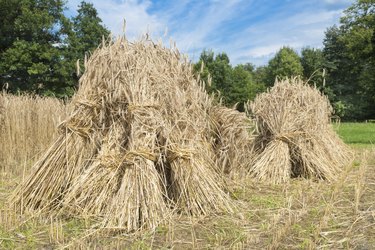
In addition to meaning "a quantity of the stalks and ears of a cereal grass or sometimes other plant material bound together" or "something that resembles a sheaf of grain," "sheaf" can mean "a large amount or number" of anything, according to the Merriam-Webster dictionary.
Etymology
Video of the Day
"Sheaf" was an important word for Anglo-Saxons, as some of them claimed a man named Sheaf was their legendary earliest ancestor, who, while an infant, arrived mysteriously from the sea. As he grew older, his prowess and popularity grew greater and he became king of the people.
Video of the Day
Early Agricultural Practices
The practice of binding and tying cut grasses or grain stalks into sheaves is a step in the harvesting process. In earlier times, farmers cut grass and grain by hand using or scythes. Once cut, the stalks were bundled and bound into sheaves; the sheaves were bundled together upright to dry. These larger bundles, made up of sheaves, were called "shocks." A shock of summer wheat consisted of 12 sheaves; a shock of winter wheat or rye contained 18 sheaves. When dry, the sheaves could be threshed. The seed was collected for food and the remaining straw, or chaff, was used to feed livestock.
How Much Grain in a Sheaf?
Hebrew scholars equate the term "sheaf," an amount of grain large enough to require bundling, with the Hebrew term "omer." An omer was a unit of dry measure equal to 4 dry pints. A sheaf was a size that could be put under the arm.
Sheaf as a Symbol
Anthropologists argue the conflation of grain with gods or royalty points to various earlier cults of a "Grain Mother," which they support with examples taken from a variety of cultural mythologies. The sheaf often symbolizes fertility and prosperity. In Genesis 37:7, Joseph tells his brothers about his dream: "We were binding sheaves of grain out in the field when suddenly my sheaf rose and stood upright, while your sheaves gathered around mine and bowed down to it." The brothers interpret the dream to mean that Joseph will become more prosperous than they, so they throw him in a pit and leave him, and tell their father he was killed by a wild animal.
Modern Farming
In Western Europe and in the United States, the hand-cutting and binding method of harvesting persisted more or less unchanged from the Middle Ages until the time of the Industrial Revolution, when the invention of the steam engine led to the invention of a steam-powered plow. From there, inventions multiplied. Whereas hired hands used to come to a farm during the harvesting season to bind the sheaves and shocks, the new plows had increasing capabilities and eventually included the ability to automatically sheave the grain as it was plowed. Today, in most industrialized countries, a giant piece of equipment called the combine is used to harvest grain. It cuts and threshes the grain all at once, eliminating the need for binding.